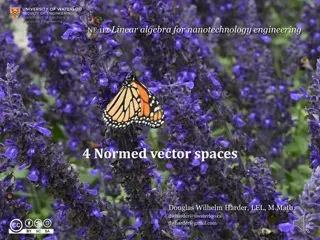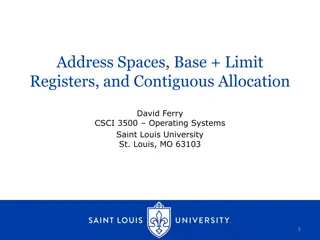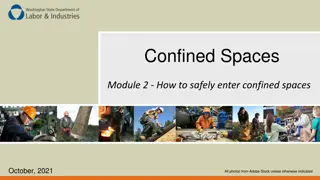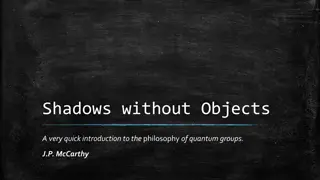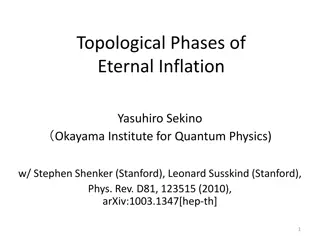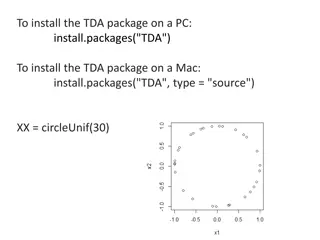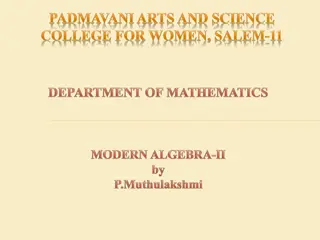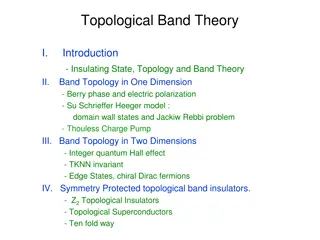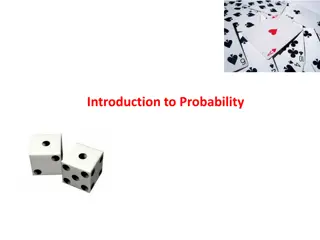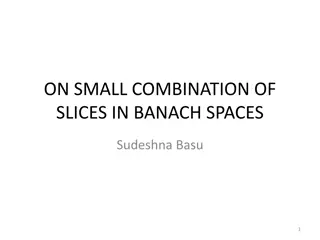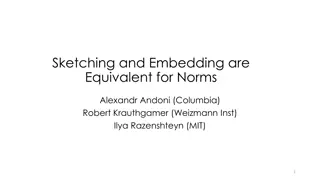Introduction to Topological Spaces and Examples
Topology is the study of surfaces derived from Greek words meaning surface and discourse. In mathematics, a topological space is a set with a family of subsets satisfying specific properties. Examples include the open ball, open set, indiscrete topology, discrete topology, co-finite topology, and co-countable topology. Different topologies can be compared in terms of strength. Understanding these fundamental concepts is crucial for advanced studies in mathematics.
Download Presentation

Please find below an Image/Link to download the presentation.
The content on the website is provided AS IS for your information and personal use only. It may not be sold, licensed, or shared on other websites without obtaining consent from the author.If you encounter any issues during the download, it is possible that the publisher has removed the file from their server.
You are allowed to download the files provided on this website for personal or commercial use, subject to the condition that they are used lawfully. All files are the property of their respective owners.
The content on the website is provided AS IS for your information and personal use only. It may not be sold, licensed, or shared on other websites without obtaining consent from the author.
E N D
Presentation Transcript
Prof.Retheesh R Department of Mathematics
INTRODUCTION TOPOLOGICAL SPACES EXAMPLES OF TOPOLOGICAL SPACES BASES AND SUB BASES REFERENCES
The word Topology Greek words topos meaning surface and logos meaning discourse or study . Topology thus literally means study of surfaces. Topology is derived from the two
Definitions Open ball: Let x0 X and r be a positive real number. Then the open ball with centre x0 and radius r is defined to be the set { x X: d(x, x0)<r } which is denoted either by Br(x0) or by B(x0,r). It is also called open r ball around x0. Open set: A subset A X is said to be open if for every x0 A there exists some open ball around x0 which is contained in A, that is ,there exists r>0 such that B(x0,r) A.
TOPOLOGICAL SPACE A topological space is a pair (X , ) where X is a set and is a family of subsets of X satisfying. i. and X ii. is closed under arbitrary unions, iii. is closed under finite intersections. X. Members of are said to be open in X or open subsets of X. The family is said to be a topology on set
Indiscrete topology: The topology on the set X consist of only and X. The Indiscrete topology is induced by the Indiscrete pseudo- metric on X. Discrete topology : Here the topology coincides with the power set P(X). The discrete topology is induced by the discrete metric. Co-finite topology : A subset A of X is said to be co-finite, if its complement, X-A is finite. Let consists of all co-finite subsets of X and the empty set. In the case X is finite it coincides with the discrete topology but otherwise it is not the same.
Co-countable topology : The co-countable topology on a set is defined by taking the family of all sets whose complements are countable and the empty set. The usual topology : The usual topology on R is defined as the topology induced by the Euclidean metric.
DEFINITION The topology 1 is said to be weaker coarser set) if 1 2 as the subsets of the power set. THEOREM Let X be a set { 1:i I} be an indexed family of topologies on X. let = Then is a topology on X. It is weaker than each i ,i I. If is a any topology on X which is weaker than each i ,i I,then is stronger than . DEFINITION weaker (or coarser) than the topology 2 (on the same THEOREM
Let X be a set and a family of subsets of X. Then there exists a unique topology on X, such that it is the smallest topology on X containing .
BASES AND SUB -BASES DEFINITION Let (X, ) be a topological space. A subfamily of is said to be a base for if every member of can be expressed as the union of some members of . PREPOSITION Let (X, ) be a topological space and . Then is a base for iff for any x X and any open set G containing x, there exists B such that x B and B containing G.
A space is said to satisfy the second axiom of countability or is said to be second countable if its topology has a countable base. THEOREM If a space is second countable then every open cover of it has a countable subcover.
PROPOSITION 1: Let 1, 2 be two topologies for a set having bases 1 2 respectively. Then 1 is weaker than 2 iff every member of 1 can be expressed as a union of some members of 2. PROPOSITION 2: Let X be a set and a family of its subsets covering X. Then the following statements are equivalent : (1) There exists a topology on X with as base. (2) for any 1 , 2 and x 1 n n 2 there exists 3 such that x 3 and 3 contain 1 n n 2 (3) for any 1 , 2 , 1 n n 2 can be expressed as the union of some members of
Let X be a set, a topology on X and a family of subsets of X. Then is a sub-base for iff generates Given any family of subset of X , there is a unique topology on X having as a sub- base. Further, every member of can be expressed as the union of sets each of which can be expressed as the intersection of finitely many members of .
K D JOSHI- INTRODUCTION TO GENERAL TOPOLOGY (SECOND EDITION) ,NEW AGE INTERNATIONAL PUBLISHERS




